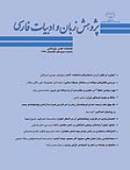مقايسه کارنامة اردشير بابکان و افسانههاي کتاب منتسب به بارسوما بر اساس گزارش موسي خورني
محورهای موضوعی : پژوهشهای ادبیات کلاسیک ایران
1 -
کلید واژه: کوروش خورهبود بارسوما راستسخن حماسههاي تاريخي ساساني شاهنامه,
چکیده مقاله :
اطلاعات بسيار مهمي دربارة وجود کتابي به زبان يوناني در تاريخ و افسانههاي ايراني که بخشي از آن شبيه کارنامه اردشير بابکان به نظر میرسد، در نوشتههاي نخستين مورخ ارمني قرن پنجم ميلادي، موسي خُورِني، ثبت شده است. در گزارش کوتاهِ اين مورخ، بخشي از اين افسانهها دربارة اردشير و بخش ديگري از آنها به شخصيتهاي اساطيري و تاريخي ديگر مربوط ميشوند، اما غالب محققان و از جمله تئودور نولدکه، به اشتباه، همة اين افسانهها را یکجا مربوط به اردشير پنداشتهاند. اين امر به استنتاج نادرست در ديگر زمينهها بهويژه دربارة افسانه پرورش کوروش انجاميده است. از سوي ديگر اساساً این گزارش خورني دربارة کتاب مذکور که حاوي نام نويسنده و نيز مترجم ايراني آن هم هست، سخت مورد بيتوجهي قرار گرفته است. در مقالة حاضر دلايل رد اين اشتباهِ رايج، بيان شده و علاوه بر آن کوشش شده تا به ويژه بر اساس پژوهشهاي جديد محققان ارمني و با تکيه بر اصول زبانشناسي، به تجزيه و تحليل گزارش خورني و مقايسه آن با متن کارنامه پرداخته شود. از نامهاي نويسنده و مترجم کتاب که تاکنون ناشناخته مانده و فقط با ضبطهاي آشفته و مغشوش در معدودي از کتابها آمده، نیز صورتبندي صحيحتري ارائه گردیده است. برای اطمینان بیشتر افسانههايي که خورني به آنها اشاره کرده با متن کارنامه، ترجمههاي ارمني و فرانسه و نيز با روايت شاهنامه مقابله شده است. نتايج بهدست آمده ميتواند براي پژوهش درباره کارنامه اردشير بابکان، اساطير و ادبيات ايران باستان و مخصوصاً منابع از ميان رفتهاي همچون خداينامه و تاريخ روابط ادبي ايران و غرب در دورة باستان و ارزیابی شیوه تاریخنویسی موسی خورنی راهگشا باشد.
There exists important information about a Greek book on Persian history and legends recorded in the writings of Movses of Khoren, the first Armenian historian of the 5th century. Part of the book seems comparable to Kārnāme-e Ardešīr-e bābakān) or Book of the Deeds of Ardešīr, Son of Papag. In his short report, some of the legends relate to Ardešīr, and some relate to other Persian mythical and historical figures. However, most researchers, and among them Theodor Nöldeke, have attributed these legends exclusively to Ardešīr I, a mistake that caused some inaccurate conclusions particularly about the legend of Cyrus’s childhood and upbringing. Besides, Khorn’s report, including the author’s name, and the name of its Persian translator, has totally been ignored. The present paper explains our reasons for rejecting the false common claims, and tries to make a close analysis of Khoren’s report based on linguistic principles and the latest researches of the Armenian researchers, and then compare it with Kārnāme. Meanwhile, it clarifies the identities of the book’s author and the translator, giving their correct names already recorded disorderly and in just few resources. To make sure, legends in Khoren’s text is contrasted with its French and Armenian translations, Kārnāme, and Shāhnāme. The findings of the research can be used in studies on Kārnāme-e Ardešīr-e bābakān, the mythology and literature of the Ancient Iran, the ancient history of Persia and the West, and particularly the lost resources like Khodāy- Nāmak (Book of Kings). They can also be beneficial in evaluating Khoren’s style of historiography.


